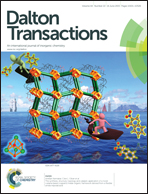Organotin(iv) based anti-HCV drugs: synthesis, characterization and biochemical activity†
Abstract
Three new organotin(IV) carboxylates (1–3) of 3,5-dimethylbenzoate, have been synthesized and characterized by elemental analysis, FT-IR, multinuclear NMR (1H, 13C and 119Sn), mass spectrometry and single crystal X-ray structural analysis. Crystallographic data show that in compounds 1 and 2, the geometry at the central Sn atom is skew-trapezoidal bipyramidal while compound 3 displays a distorted trigonal bipyramidal coordination geometry. In the case of compounds 1 and 2, the asymmetric chelating mode of the carboxylate groups is reflected in the unequal C–O bond distances, those observed for the O1 and O3 oxygen atoms being significantly longer than those found in the O2 and O4 atoms. In the case of compound 3, the carboxylate groups bridge asymmetrically adjacent tin atoms in an anti–syn mode generating polymeric zigzag chains running parallel to the crystallographic c-axis. The compounds were screened for anti-HCV (hepatitis C virus) potency by the Gaussia luciferase assay using infected Huh 7.5 cells (human hepatocellular cell). Structure–activity relationship studies led to the identification of dibutyltin(IV)bis(3,5-dimethylbenzoic acid) (compound 1) as a potent HCV inhibitor, with log IC50 values equal to 0.69 nM in the cell-based assay. Compound 1 was further subjected to quantitative analysis using real-time PCR assays and viral RNA count vs. drug concentration confirmed the Gaussia luciferase assay results. The HCV RNA targeting mode of the compounds (1–3) was confirmed by a compound–DNA interaction study. The compounds (1–3)–DNA interactions were investigated by UV–vis spectroscopy and viscometry. The hypochromic effect in spectroscopy evidenced an intercalative mode of interaction with the binding affinity in the order of 1 > 3 > 2.


 Please wait while we load your content...
Please wait while we load your content...